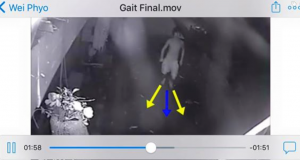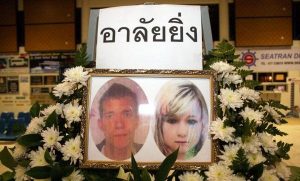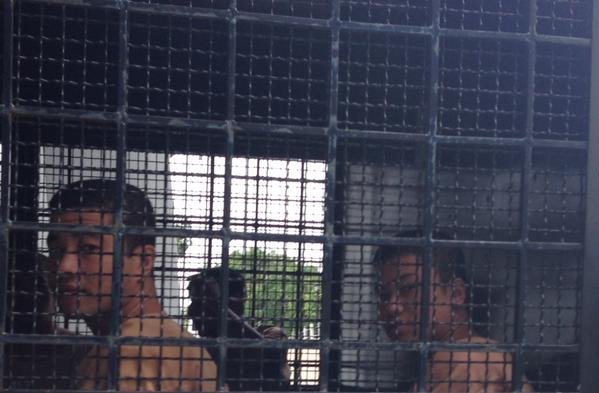The trial of Burmese migrant workers Zaw Linn and Win Zaw Htun, accused of murdering two British holidaymakers, continued yesterday in Koh Samui Courthouse.
Migrant rights advocate Andy Hall presented the findings of his investigation on behalf of the accused. Hall, an advisor to the Thai defence team, told DVB there has never been any evidence that linked the Burmese men to the murders of Hannah Witheridge and David Miller.
In a case that has been riddled with confusion from the outset, the mishandling of DNA was a centre point of Hall’s testimony, where he presented a pathology report prepared by a British pathologist and a gait analysis of CCTV footage.
The prosecution claims the footage, which shows a man running from near the crime scene, implicates Win Zaw Htun in the crime. UK private contracting company Acume Forensics independently examined the footage and claims the ‘running man’ cannot be Win Zaw Htun.

“It was a great opportunity to raise doubts about the prosecutions case. I raised significant doubts on the validity of the Thai autopsy report. The person running on the CCTV footage, which is one of the crucial parts of evidence for the prosecution, is not the defendant [Win Zaw Htun], according to the gait analysis by a UK expert.
“There were substantial differences between the Thai autopsy report, and the British autopsy report,” said Andy Hall.
While unable to detail the nature of those differences, Hall confirmed they were in relation to injuries sustained during the sexual assault of Witheridge. Hall submitted more than 400 pages of the British autopsy report to the court.
Thai police claim that forensic testing of Witheridge’s body revealed sperm from the two accused was present in her genitals.
However, the defence team maintains that the report detailing this evidence is in fact inconclusive, poorly prepared, and ‘scribbled down in handwriting and sloppy’. Many observers are critical of the original report, questioning whether the document should be considered admissible in the case.
Thai authorities have not made their own report and photographs available, stating that they do not have the budget to print the findings, according to Andy Hall.
“They said they have all the photographs, but no budget, no money to print them out. We asked for them on a CD, but they said ‘no’,” he said.
“Crucial evidence in these intimate crimes is the clothes the female was wearing. Her skirt and her t-shirt have disappeared. Her underwear was found on the beach, but never tested. The Thai police still have her underwear.”

Hall reported that despite the ‘horrific conditions’ in Koh Samui jail, the accused are in good spirits and eager to testify themselves.
“They are incredibly confident, happy, and in good health. They have adjusted incredibly well to the horrific conditions, where there is not even enough food to survive. They are eager to tell the world what they know,” he said.
Aung Myo Thant, an observer on behalf of the Burmese Embassy, told DVB outside the hearing on Tuesday that original DNA results submitted by the Thai police came back unusually quickly, casting aspersions on their accuracy.
“A forensic expert from the Central Institute of Forensic Science testified at the hearing this morning, concerning the DNA found on a plastic bag, a shoe, and the garden hoe. The expert asserted that the DNA sample was similar to that of Win Zaw Htun, but was not significant enough to qualify [as matching Win Zaw Htun].
“The [expert] also noted how the police conducted the DNA testing on the two suspects. Usually the process is given a timeframe of about 20 days – 10 days if the case is urgent – but the police took their DNA samples on 2 October 2014, and the results were returned on 5 October 2014, claiming the samples matched the suspects. It is not at all believable,” Aung Myo Thant said.
Also speaking outside Koh Samui courthouse after the days’ proceedings concluded, Nakhon Chompuchat, the lead lawyer for the defence, said that it is now up to the judge on whether he still gives credibility to the police evidence.
“We have proof that the police’s investigation is not credible, and questionable in the way they handled the evidence, which we always bring up to the court. It is becoming more obvious,” he told Reuters.
Thai police have been widely criticised for their handling of the investigation, which has attracted significant international attention. Many observers have accused the local authorities of being complicit in a cover-up, in addition to claims the two Burmese migrant workers were coerced into their original confession – which they later recanted, stating it was extracted under duress of torture.
The Arakanese suspects both face the death penalty if convicted of the murders. The backpackers were found murdered on Koh Tao, an island popular with tourists and divers. The body of Witheridge showed signs of rape, and both are believed to have sustained substantial injuries before their deaths.

Earlier in the hearing, renowned Thai forensics expert Dr Pornthip Rojanasunand accused the police of mishandling crucial forensic evidence, botching the legitimacy of their claims that the DNA found on the murder weapon matches that of the suspects.
[related]
Sein Htay, a spokesperson for the Migrant Worker Rights Network, told DVB that the test carried out by Dr Pornthip, the director of Thailand’s Central Institute of Forensic Science, failed to establish a link between the two young men and the hoe used in the murders.
“According to [Dr Pornthip], the DNA test could not establish a connection between the murder weapon and the two young defendants. Previously, the police claimed there was no DNA sample or fingerprints found on the hoe. But the test by Dr Pornthip and her team found two male DNA samples – one complete profile and the other only partial – on the handle of the hoe. But neither of these match the defendants’ DNA,” he said.
Further impeding the case is the unavailability of the original DNA, taken from the crime scene, to be independently re-tested. Police continue to maintain, despite the impossibility of verification, that DNA from the garden hoe identified as the murder weapon matches that of the Burmese suspects.
Scotland Yard conducted their own investigation in October 2014, but the results were never made public.
Read more on the Koh Tao case here.



